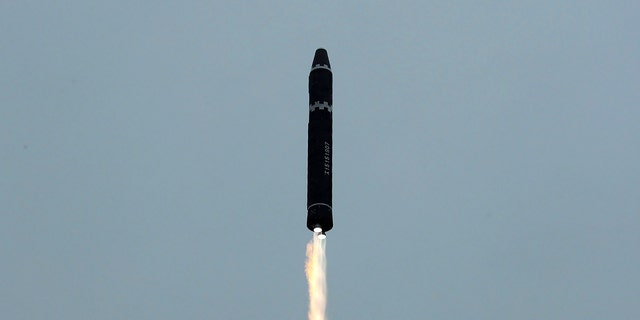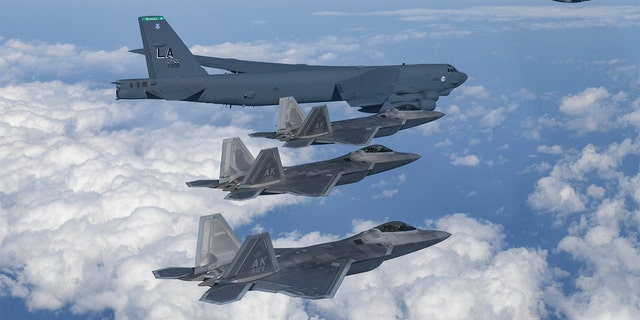North Korea confirms ICBM test, warns of more powerful steps in response to South Korea, US trainings
North Korea confirmed Sunday the intercontinental ballistic missile test conducted Saturday was meant to further bolster its “fatal” nuclear attack capacity against its rivals, according to The Associated Press. The country also threatened additional powerful steps in response to the planned military training between the U.S. and South Korea.
In its first missile test since Jan. 1, North Korea’s official Korean Central News Agency said the launch involved the existing Hwasong-15 ICBM and was organized “suddenly” without prior notice at leader Kim Jong Un’s order.
The launch was designed to verify the weapon’s reliability and the combat readiness of the country’s nuclear force, KCNA reported. It also signals that Kim Jong Un is using his rivals’ drills as an opportunity to expand the North’s nuclear capability, aiming to enhance its leverage in future dealings with the U.S.
An expert added the North may seek to hold regular operational exercises involving its ICBMS, The AP said.
NORTH KOREA FIRED BALLISTIC MISSILE INTO EAST SEA, SOUTH KOREA AND JAPAN SAYS
KCNA also reported the missile was fired at a high angle and reached a maximum altitude of about 5,770 kilometers (3,585 miles). It also flew at a distance of approximately 990 kilometers (615 miles) for 67 minutes before accurately hitting a pre-set area in waters between the Korean Peninsula and Japan.
Flight details reported by North Korea, which lined up with the information assessed by its neighbors, show the weapon is theoretically capable of reaching the mainland U.S. if fired at a standard trajectory.
The KCNA said Saturday’s launch demonstrated NK’s “powerful physical nuclear deterrent” and its efforts to “turn its capacity of fatal nuclear counterattack on the hostile forces” into an extremely strong one that cannot be countered.
Whether North Korea has a functioning nuclear-tipped ballistic missile remains a source of debate. Some experts say the country hasn’t mastered the technology needed to protect warheads from the severe conditions of atmospheric reentry – the country claims it does have such technology.
NORTH KOREA THREATENS ‘UNPRECEDENTEDLY’ STRONG RESPONSE TO US-SOUTH KOREAN NUCLEAR DRILLS

The Hwasong-15 is one of the North’s three existing ICBMS, all of which use liquid propellants that require pre-launch injections and cannot remain fueled for extended periods. The country is pushing to build a solid-fueled ICBM, which would be more mobile and harder to detect before its launch.
Korea Aerospace University Missile Expert Chang Young-Keun said the Hwasong-15 ICBM launched on Saturday appeared to be an upgraded version, as the information provided by NK showed the missile would likely have a longer potential range than the standard.
The North’s launch came a day after it vowed an “unprecedentedly” strong response over an upcoming series of military drills planned by Seoul and Washington, D.C. – which NK has repeatedly slammed and referred to as an “invasion rehearsal.”
In a separate statement Sunday, Kim Yo Jong, the influential sister of Kim Jong Un, accused South Korea and the U.S. of “openly showing their dangerous greed and attempt to gain the military upper hand and predominant position in the Korean Peninsula.”
“I warn that we will watch every movement of the enemy and take corresponding and very powerful and overwhelming counteraction against its every move hostile to us,” she said.

SOUTH KOREA REFERS TO NORTH AS ‘OUR ENEMY’ FOR FIRST TIME IN SIX YEARS AS TENSIONS HEIGHTEN
Soo Kim, a security analyst at the RAND Corporation, said it’s clear that North Korea will consider any action taken by the U.S. and South Korea as an “act of hostility,” regardless of how justified the action may be in response to the North’s “reckless behavior.”
“With nuclear weapons in tow and having mastered the art of coercion and bullying, Kim does not need ‘self-defense.’ But pitting the U.S. and South Korea as the aggressors allows Kim to justify his weapons development,” Soo Kim said.
U.S. National Security Council Spokesperson Adrienne Watson ensured the U.S. would take “all necessary measures” to protect the American homeland, South Korea and Japan. South Korea’s presidential National Security Council said it would seek to strengthen its “overwhelming response capacity” against potential aggression based on the alliance with the U.S. military.
South Korean and U.S. militaries plan to hold a tabletop exercise this week to sharpen a joint nuclear weapon response plan. In March, the allies will also conduct field training, another joint computer simulated exercise.

Last year, North Korea set an annual record with the launch of more than 90 missiles. It also passed a law that allows it to use nuclear weapons preemptively in a broad range of scenarios.
Kim Jong Un entered 2023 with a call for an “exponential increase” of the country’s nuclear warheads, mass production of battlefield tactical nuclear weapons targeting South Korea and the development of more advanced ICBMs targeting the U.S.
The Associated Press contributed to this report.
Read the full article Here


